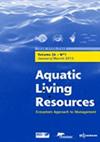浅水水力采蛤的影响及将人为干扰纳入生境评估的重要性
IF 1.5
4区 农林科学
Q3 FISHERIES
引用次数: 0
摘要
众所周知,对贝类的水力疏浚会产生一些最高程度的干扰,影响底栖微动物群落和底物的物理特性。正确进行底栖生物栖息地评估是复杂和耗时的,导致没有进行评估,增加了影响后研究的不确定性。2014-2015年冬季,马萨诸塞州鲱鱼湾(Herring Cove)对大西洋蛤(Spisula soldidissima)进行了水力疏浚,导致海底受到高冲击干扰。2015年夏天进行的调查包括水声、底栖无脊椎动物采样、视频和粒度分析,以创建鲱鱼湾的栖息地地图。确定的四个栖息地(a - d)是沙子,贝壳,鹅卵石,藻类和鳗草的混合物。生境类型“D”是沙子、藻类和鹅卵石材料的混合物,在18个站点中的12个出现。这12个站点分布在“高”(n = 4)、“低”(n = 2)和“无”(n = 6)水力疏浚扰动区域。一旦将栖息地考虑在内,底栖无脊椎动物群落结构就会发生显著变化(相似性分析;“高”、“低”和“无”干扰区域之间的样本统计显著性水平为0.3%。疏浚道覆盖率“低”至“无”的地区,双壳类、棘皮类和等足类的丰度较高,而高度受干扰的地区,多毛纲和寡毛纲的丰度最高。未来的制图工作,特别是有生物成分的调查,需要包括和量化人为变化的水平、类型和空间分布。应更多地注意“参考地图”而不是“基线地图”。后者忽略了先前存在的人为干扰,并有可能歪曲对恢复和管理工作的监测。本文章由计算机程序翻译,如有差异,请以英文原文为准。
The impacts of hydraulic clamming in shallow water and the importance of incorporating anthropogenic disturbances into habitat assessments
Hydraulic dredging for shellfish is known to create some of the highest levels of disturbance, affecting the benthic microfaunal community and the physical characteristics of the substrate. Properly conducted benthic habitat assessments are complex and time consuming, resulting in assessments not being conducted increasing the uncertainty in post impact studies. Hydraulic dredging for Atlantic surfclams (Spisula soldidissima) took place at Herring Cove, Massachusetts in the winter of 2014–2015 resulting in areas of high impact disturbance of the seafloor. Surveys conducted in the summer of 2015 included hydroacoustics, benthic invertebrate sampling, video, and grain size analysis for the creation of a habitat map of Herring Cove. The four habitats (A–D) identified were a mix of sand, shell, cobble, algae, and eelgrass. Habitat type “D” is a mix of sand, algae and cobble material and occurred at 12 of 18 stations. These 12 stations were distributed across areas of “high” (n = 4), “low” (n = 2), and “no” (n = 6) hydraulic dredge disturbance. Once habitat was accounted for, benthic invertebrate community structure varied significantly (Analysis of similarity; significance level of sample statistic: 0.3%) between areas of “high”, “low” to “no” disturbance. Areas of “low” to “no” dredge track coverage contained high abundances of bivalves, echinoderms, and isopods, whereas highly disturbed areas had highest abundances of polychaetes and oligochaetes. Future mapping efforts, especially surveys with biological components, need to include and quantify the level, type and spatial distribution of anthropogenic alterations. More attention should be given to “reference maps” instead of “baseline maps”. The latter of which omits to acknowledge pre-existing anthropogenic disturbances and has the potential to skew monitoring of restoration and management efforts.
求助全文
通过发布文献求助,成功后即可免费获取论文全文。
去求助
来源期刊

Aquatic Living Resources
农林科学-海洋与淡水生物学
CiteScore
2.30
自引率
0.00%
发文量
10
审稿时长
>24 weeks
期刊介绍:
Aquatic Living Resources publishes original research papers, review articles and propective notes dealing with all exploited (i.e. fished or farmed) living resources in marine, brackish and freshwater environments.
Priority is given to ecosystem-based approaches to the study of fishery and aquaculture social-ecological systems, including biological, ecological, economic and social dimensions.
Research on the development of interdisciplinary methods and tools which can usefully support the design, implementation and evaluation of alternative management strategies for fisheries and/or aquaculture systems at different scales is particularly welcome by the journal. This includes the exploration of scenarios and strategies for the conservation of aquatic biodiversity and research relating to the development of integrated assessment approaches aimed at ensuring sustainable and high quality uses of aquatic living resources.
 求助内容:
求助内容: 应助结果提醒方式:
应助结果提醒方式:


